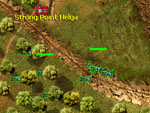 When I reviewed Close Combat II: A
Bridge Too Far, I closed by saying that I’d love to see another title in the series,
and specifically mentioned Stalingrad as the battle I’d most like to see the engine
brought to bear on. Well, for the third installment in the series, Microsoft and Atomic
Games have done me one better--Close Combat III: The Russian Front covers the entire war
in the East from ’41 to 45. Now, the Russian Front is every hardcore WWII
gamer’s favorite, and with good reason. It’s got tons of drama--Der Vaterland vs
Mother Russia on a stage that spanned four long years of brutal combat on a front
stretching from the Black Sea to the Arctic Circle, from the Caucasus to the Elbe. It was
a massive conflict, and that may be this ambitious game’s biggest problem. While the
first two games in the series merely covered the Normandy campaign until St. Lo and the
Market-Garden drops, this game tries to do everything, and in doing so it loses
some of the focus and feel of the earlier games. It’s a sticking point with me, but
that’s about the only thing lacking here; otherwise, the game is very
much-improved--from the interface to the graphics to some great new features that CCers
have pleading for since the first game. When I reviewed Close Combat II: A
Bridge Too Far, I closed by saying that I’d love to see another title in the series,
and specifically mentioned Stalingrad as the battle I’d most like to see the engine
brought to bear on. Well, for the third installment in the series, Microsoft and Atomic
Games have done me one better--Close Combat III: The Russian Front covers the entire war
in the East from ’41 to 45. Now, the Russian Front is every hardcore WWII
gamer’s favorite, and with good reason. It’s got tons of drama--Der Vaterland vs
Mother Russia on a stage that spanned four long years of brutal combat on a front
stretching from the Black Sea to the Arctic Circle, from the Caucasus to the Elbe. It was
a massive conflict, and that may be this ambitious game’s biggest problem. While the
first two games in the series merely covered the Normandy campaign until St. Lo and the
Market-Garden drops, this game tries to do everything, and in doing so it loses
some of the focus and feel of the earlier games. It’s a sticking point with me, but
that’s about the only thing lacking here; otherwise, the game is very
much-improved--from the interface to the graphics to some great new features that CCers
have pleading for since the first game.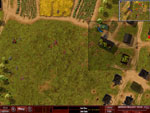 For those of you unfamiliar with the
Close Combat series, it combines a real-time engine with historical battles—think of
a combination of Squad Leader and Total Annihilation without the construction. You command
about 15 units—each made up of a squad of infantry or a single vehicle or gun—as
you battle your way through a series of skirmishes that make up a larger campaign or
operation. Though the turn-based crowd turned its nose up initially, the series’
combination of historical veracity and real-time excitement has since converted all but
the most intractable grognards, and has been a big hit for Microsoft. For those of you unfamiliar with the
Close Combat series, it combines a real-time engine with historical battles—think of
a combination of Squad Leader and Total Annihilation without the construction. You command
about 15 units—each made up of a squad of infantry or a single vehicle or gun—as
you battle your way through a series of skirmishes that make up a larger campaign or
operation. Though the turn-based crowd turned its nose up initially, the series’
combination of historical veracity and real-time excitement has since converted all but
the most intractable grognards, and has been a big hit for Microsoft.
In CC3, you’ll be able to fight 27 stand-alone historical
battles, 16 historical operations—which consist of a series of battles fought in
sequence, and 15 historical campaigns—a series of operations fought in sequence. Or,
for the ultimate East Front gamer’s challenge, you can fight the Grand Campaign, in
which you’ll fight all 16 operations, battling from the opening moves of Barbarossa
to the final curtain in the streets of Berlin. I found the game’s selection of
battles to be very good—the usual suspects are here, including Moscow, Stalingrad,
Kharkov and Kursk. But there are some surprises as well, including the Korsun Pocket
campaign, Operation Star, and the Russian ’44 offensives. As you progress in the
campaigns, you can buy new troops and upgrade old units, and your troops will gain in
experience as the war grinds on.
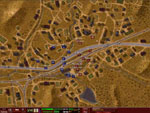 The game’s epic scale is reflected in its maps as well, which are
three to four times larger than those in CC1 And CC2; really, you can just about get lost
on them. They look great, too, and do a fine job of conveying the varied terrain the
Wehrmacht and Red Army fought across. And while the first two games didn’t account
for elevation differences in the terrain, on these maps hills provide dominating fields of
fire and gullies very handy cover. Most of the time you can pretty much tell where the
elevation differences are, but sometimes you’ll be surprised by a Panzerfaust team in
a difficult-to-spot hiding place. It’s a good idea to run your firing lines over the
terrain before the game starts, just to see where the bad guys might be lurking. And
though you won’t be able to edit the maps themselves, the game does include a mission
editor with which you can create your own scenarios. The game’s epic scale is reflected in its maps as well, which are
three to four times larger than those in CC1 And CC2; really, you can just about get lost
on them. They look great, too, and do a fine job of conveying the varied terrain the
Wehrmacht and Red Army fought across. And while the first two games didn’t account
for elevation differences in the terrain, on these maps hills provide dominating fields of
fire and gullies very handy cover. Most of the time you can pretty much tell where the
elevation differences are, but sometimes you’ll be surprised by a Panzerfaust team in
a difficult-to-spot hiding place. It’s a good idea to run your firing lines over the
terrain before the game starts, just to see where the bad guys might be lurking. And
though you won’t be able to edit the maps themselves, the game does include a mission
editor with which you can create your own scenarios.
And you’ll command and fight a wide variety of troops as
well. The game includes more than 100 weapon types, 60 infantry types, and over 80
different vehicles and guns. There’s an enormous difference between Guards troops and
militia, between the early light tanks of the Blitzkrieg to the Stalins and Panthers of
the late war. One of the best things about the campaign is how it allows you to experience
for yourself how tactics evolved as the equipment edge swung from one side to the other.
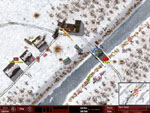 The game also
sports a much-improved interface; you can group-move units by drag-selecting them, set
waypoints (woohoo!) by shift-clicking, and pathfinding (especially for tanks) is much
better. No longer do you have to hold up your attacks while you tanks cut doughnuts in
someone’s front yard; now they respond promptly. Even better are the new ambush and
defend orders, which allows you to set your unit’s facing and tell it to hold its
fire—in the ambush’s case, until a enemy unit comes within 30 yards. This can be
a devastating tool, especially in the Stalingrad scenarios, and very especially when using
flamethrowers. The commander unit is another new addition, and can be used to rally
troops, to increase a unit’s morale, and to increase the odds that men under his
command will follow orders. He seems to be more of a preventative measure than a remedy;
in my games, commanders did a good job of holding troops (especially lousy ones) in line.
But when I’d try to rally even excellent troops or con cowering tank crews into
retaking their stations in abandoned tanks, I never had much success. The game also
sports a much-improved interface; you can group-move units by drag-selecting them, set
waypoints (woohoo!) by shift-clicking, and pathfinding (especially for tanks) is much
better. No longer do you have to hold up your attacks while you tanks cut doughnuts in
someone’s front yard; now they respond promptly. Even better are the new ambush and
defend orders, which allows you to set your unit’s facing and tell it to hold its
fire—in the ambush’s case, until a enemy unit comes within 30 yards. This can be
a devastating tool, especially in the Stalingrad scenarios, and very especially when using
flamethrowers. The commander unit is another new addition, and can be used to rally
troops, to increase a unit’s morale, and to increase the odds that men under his
command will follow orders. He seems to be more of a preventative measure than a remedy;
in my games, commanders did a good job of holding troops (especially lousy ones) in line.
But when I’d try to rally even excellent troops or con cowering tank crews into
retaking their stations in abandoned tanks, I never had much success.
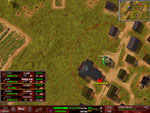 So it’s a got better maps, better multiplayer, a better interface,
improved features, and a lot more cool units than the first two games, and I gave them
both five stars. Why does this one get four? Well, this is one of those odd games that
somehow ends up being less than the sum of its parts, and that mostly has to do with the
battles themselves--which only rarely, I think, impart the feel of East Front combat. Let
me come clean: I’m a bit of a student of the East Front—I’ve read and
re-read Manstein and the old U.S. Army manuals on Wehrmacht Operations in Russia and the History
of the Great Patriotic War and Carrell’s Scorched Earth and Sajer’s The
Forgotten Soldier, and jeez, I’ve played probably every East Front wargame ever.
When I was in Army intelligence in Berlin, I used to go around gawking at the bullet holes
in the Reichstag and the old neighborhoods where the hardest fighting took place.
It’s probably not healthy, but I know a lot about the Eastern Front. So it’s a got better maps, better multiplayer, a better interface,
improved features, and a lot more cool units than the first two games, and I gave them
both five stars. Why does this one get four? Well, this is one of those odd games that
somehow ends up being less than the sum of its parts, and that mostly has to do with the
battles themselves--which only rarely, I think, impart the feel of East Front combat. Let
me come clean: I’m a bit of a student of the East Front—I’ve read and
re-read Manstein and the old U.S. Army manuals on Wehrmacht Operations in Russia and the History
of the Great Patriotic War and Carrell’s Scorched Earth and Sajer’s The
Forgotten Soldier, and jeez, I’ve played probably every East Front wargame ever.
When I was in Army intelligence in Berlin, I used to go around gawking at the bullet holes
in the Reichstag and the old neighborhoods where the hardest fighting took place.
It’s probably not healthy, but I know a lot about the Eastern Front.
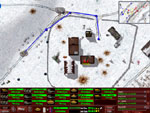 And I have
trouble reconciling my knowledge with some of the scenarios, especially in the campaign.
For example, in the Prokhorovka scenario, which supposedly represents the largest tank
battle ever, my seven tanks—a Pzkw IV/Panther/Tiger mix—ran into only four
Russkie tanks—a couple of KVs and some T-34 76s. My guys torched them pretty easily,
and then it was just a matter of negotiating a few trenches and skittering between
minefields to wipe out the unprotected infantry—no AT guns, no reserves, no nothing.
And then—and this happens way too often in the game—the scenario just ended.
It’s strange, but even though the game boasts these enormous maps, in many scenarios
you’ll just have to fight about halfway through them to make the enemy split and the
scenario end. So the game’s version of Kursk lasts ten minutes max. Huh? And the
Stalingrad scenarios. Oh, man. Stalingrad was an absolute hell-hole, with fierce, brutal
house-to-house fighting. Every inch was contested. But that’s not the feel you get
from the scenarios in CCIII, where you spend a good amount of your time playing
"where’s the enemy?" It feels a lot more like a bug-hunt from some sort of
Aliens movie than the claustrophobic meatgrinder of Stalingrad. And I have
trouble reconciling my knowledge with some of the scenarios, especially in the campaign.
For example, in the Prokhorovka scenario, which supposedly represents the largest tank
battle ever, my seven tanks—a Pzkw IV/Panther/Tiger mix—ran into only four
Russkie tanks—a couple of KVs and some T-34 76s. My guys torched them pretty easily,
and then it was just a matter of negotiating a few trenches and skittering between
minefields to wipe out the unprotected infantry—no AT guns, no reserves, no nothing.
And then—and this happens way too often in the game—the scenario just ended.
It’s strange, but even though the game boasts these enormous maps, in many scenarios
you’ll just have to fight about halfway through them to make the enemy split and the
scenario end. So the game’s version of Kursk lasts ten minutes max. Huh? And the
Stalingrad scenarios. Oh, man. Stalingrad was an absolute hell-hole, with fierce, brutal
house-to-house fighting. Every inch was contested. But that’s not the feel you get
from the scenarios in CCIII, where you spend a good amount of your time playing
"where’s the enemy?" It feels a lot more like a bug-hunt from some sort of
Aliens movie than the claustrophobic meatgrinder of Stalingrad.
The only conclusion I can come to is that they tried to do too
much with this one. It just may not be possible to represent the epic aspects of Kursk or
Karkhov on the tactical scale in three little scenarios, and perhaps they should have
either made the scenarios much larger—the limit of sixteen units clearly hamstrings
some operations—or they should have focused on one battle. I still think this engine
could do a Stalingrad campaign brilliantly, but that ain’t gonna happen, I guess.
Oh yeah, and the manual could have been better. It’s heavy
on tactics and historical nuggets, but there are some gameplay issues that don’t get
discussed, and which you have to learn yourself.
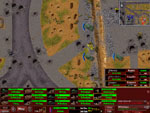 But this
isn’t a bad game; when it’s on, it’s right on, and some of the scenarios
are both challenging and a ton of fun. Even the campaign has its moments; I remember the
first time I played the Germans; we stomped our way to the gates of Moscow and beyond,
only to be drawn up very short by bad weather, critical supply shortages, and the
appearance of Russian tanks I couldn’t even think of stopping. It felt realistic;
unfortunately, there just aren’t enough moments like that. Nevertheless, the greatly
improved interface and helpful new features--as well as the compelling subject matter and
excellent multiplayer game--still make this game well worth the purchasing; it’s just
not the classic that the first two were. But this
isn’t a bad game; when it’s on, it’s right on, and some of the scenarios
are both challenging and a ton of fun. Even the campaign has its moments; I remember the
first time I played the Germans; we stomped our way to the gates of Moscow and beyond,
only to be drawn up very short by bad weather, critical supply shortages, and the
appearance of Russian tanks I couldn’t even think of stopping. It felt realistic;
unfortunately, there just aren’t enough moments like that. Nevertheless, the greatly
improved interface and helpful new features--as well as the compelling subject matter and
excellent multiplayer game--still make this game well worth the purchasing; it’s just
not the classic that the first two were.
 --Rick Fehrenbacher --Rick Fehrenbacher |

 For those of you unfamiliar with the
Close Combat series, it combines a real-time engine with historical battles—think of
a combination of Squad Leader and Total Annihilation without the construction. You command
about 15 units—each made up of a squad of infantry or a single vehicle or gun—as
you battle your way through a series of skirmishes that make up a larger campaign or
operation. Though the turn-based crowd turned its nose up initially, the series’
combination of historical veracity and real-time excitement has since converted all but
the most intractable grognards, and has been a big hit for Microsoft.
For those of you unfamiliar with the
Close Combat series, it combines a real-time engine with historical battles—think of
a combination of Squad Leader and Total Annihilation without the construction. You command
about 15 units—each made up of a squad of infantry or a single vehicle or gun—as
you battle your way through a series of skirmishes that make up a larger campaign or
operation. Though the turn-based crowd turned its nose up initially, the series’
combination of historical veracity and real-time excitement has since converted all but
the most intractable grognards, and has been a big hit for Microsoft.
 The game’s epic scale is reflected in its maps as well, which are
three to four times larger than those in CC1 And CC2; really, you can just about get lost
on them. They look great, too, and do a fine job of conveying the varied terrain the
Wehrmacht and Red Army fought across. And while the first two games didn’t account
for elevation differences in the terrain, on these maps hills provide dominating fields of
fire and gullies very handy cover. Most of the time you can pretty much tell where the
elevation differences are, but sometimes you’ll be surprised by a Panzerfaust team in
a difficult-to-spot hiding place. It’s a good idea to run your firing lines over the
terrain before the game starts, just to see where the bad guys might be lurking. And
though you won’t be able to edit the maps themselves, the game does include a mission
editor with which you can create your own scenarios.
The game’s epic scale is reflected in its maps as well, which are
three to four times larger than those in CC1 And CC2; really, you can just about get lost
on them. They look great, too, and do a fine job of conveying the varied terrain the
Wehrmacht and Red Army fought across. And while the first two games didn’t account
for elevation differences in the terrain, on these maps hills provide dominating fields of
fire and gullies very handy cover. Most of the time you can pretty much tell where the
elevation differences are, but sometimes you’ll be surprised by a Panzerfaust team in
a difficult-to-spot hiding place. It’s a good idea to run your firing lines over the
terrain before the game starts, just to see where the bad guys might be lurking. And
though you won’t be able to edit the maps themselves, the game does include a mission
editor with which you can create your own scenarios.
 The game also
sports a much-improved interface; you can group-move units by drag-selecting them, set
waypoints (woohoo!) by shift-clicking, and pathfinding (especially for tanks) is much
better. No longer do you have to hold up your attacks while you tanks cut doughnuts in
someone’s front yard; now they respond promptly. Even better are the new ambush and
defend orders, which allows you to set your unit’s facing and tell it to hold its
fire—in the ambush’s case, until a enemy unit comes within 30 yards. This can be
a devastating tool, especially in the Stalingrad scenarios, and very especially when using
flamethrowers. The commander unit is another new addition, and can be used to rally
troops, to increase a unit’s morale, and to increase the odds that men under his
command will follow orders. He seems to be more of a preventative measure than a remedy;
in my games, commanders did a good job of holding troops (especially lousy ones) in line.
But when I’d try to rally even excellent troops or con cowering tank crews into
retaking their stations in abandoned tanks, I never had much success.
The game also
sports a much-improved interface; you can group-move units by drag-selecting them, set
waypoints (woohoo!) by shift-clicking, and pathfinding (especially for tanks) is much
better. No longer do you have to hold up your attacks while you tanks cut doughnuts in
someone’s front yard; now they respond promptly. Even better are the new ambush and
defend orders, which allows you to set your unit’s facing and tell it to hold its
fire—in the ambush’s case, until a enemy unit comes within 30 yards. This can be
a devastating tool, especially in the Stalingrad scenarios, and very especially when using
flamethrowers. The commander unit is another new addition, and can be used to rally
troops, to increase a unit’s morale, and to increase the odds that men under his
command will follow orders. He seems to be more of a preventative measure than a remedy;
in my games, commanders did a good job of holding troops (especially lousy ones) in line.
But when I’d try to rally even excellent troops or con cowering tank crews into
retaking their stations in abandoned tanks, I never had much success.
 So it’s a got better maps, better multiplayer, a better interface,
improved features, and a lot more cool units than the first two games, and I gave them
both five stars. Why does this one get four? Well, this is one of those odd games that
somehow ends up being less than the sum of its parts, and that mostly has to do with the
battles themselves--which only rarely, I think, impart the feel of East Front combat. Let
me come clean: I’m a bit of a student of the East Front—I’ve read and
re-read Manstein and the old U.S. Army manuals on Wehrmacht Operations in Russia and the History
of the Great Patriotic War and Carrell’s Scorched Earth and Sajer’s The
Forgotten Soldier, and jeez, I’ve played probably every East Front wargame ever.
When I was in Army intelligence in Berlin, I used to go around gawking at the bullet holes
in the Reichstag and the old neighborhoods where the hardest fighting took place.
It’s probably not healthy, but I know a lot about the Eastern Front.
So it’s a got better maps, better multiplayer, a better interface,
improved features, and a lot more cool units than the first two games, and I gave them
both five stars. Why does this one get four? Well, this is one of those odd games that
somehow ends up being less than the sum of its parts, and that mostly has to do with the
battles themselves--which only rarely, I think, impart the feel of East Front combat. Let
me come clean: I’m a bit of a student of the East Front—I’ve read and
re-read Manstein and the old U.S. Army manuals on Wehrmacht Operations in Russia and the History
of the Great Patriotic War and Carrell’s Scorched Earth and Sajer’s The
Forgotten Soldier, and jeez, I’ve played probably every East Front wargame ever.
When I was in Army intelligence in Berlin, I used to go around gawking at the bullet holes
in the Reichstag and the old neighborhoods where the hardest fighting took place.
It’s probably not healthy, but I know a lot about the Eastern Front.
 And I have
trouble reconciling my knowledge with some of the scenarios, especially in the campaign.
For example, in the Prokhorovka scenario, which supposedly represents the largest tank
battle ever, my seven tanks—a Pzkw IV/Panther/Tiger mix—ran into only four
Russkie tanks—a couple of KVs and some T-34 76s. My guys torched them pretty easily,
and then it was just a matter of negotiating a few trenches and skittering between
minefields to wipe out the unprotected infantry—no AT guns, no reserves, no nothing.
And then—and this happens way too often in the game—the scenario just ended.
It’s strange, but even though the game boasts these enormous maps, in many scenarios
you’ll just have to fight about halfway through them to make the enemy split and the
scenario end. So the game’s version of Kursk lasts ten minutes max. Huh? And the
Stalingrad scenarios. Oh, man. Stalingrad was an absolute hell-hole, with fierce, brutal
house-to-house fighting. Every inch was contested. But that’s not the feel you get
from the scenarios in CCIII, where you spend a good amount of your time playing
"where’s the enemy?" It feels a lot more like a bug-hunt from some sort of
Aliens movie than the claustrophobic meatgrinder of Stalingrad.
And I have
trouble reconciling my knowledge with some of the scenarios, especially in the campaign.
For example, in the Prokhorovka scenario, which supposedly represents the largest tank
battle ever, my seven tanks—a Pzkw IV/Panther/Tiger mix—ran into only four
Russkie tanks—a couple of KVs and some T-34 76s. My guys torched them pretty easily,
and then it was just a matter of negotiating a few trenches and skittering between
minefields to wipe out the unprotected infantry—no AT guns, no reserves, no nothing.
And then—and this happens way too often in the game—the scenario just ended.
It’s strange, but even though the game boasts these enormous maps, in many scenarios
you’ll just have to fight about halfway through them to make the enemy split and the
scenario end. So the game’s version of Kursk lasts ten minutes max. Huh? And the
Stalingrad scenarios. Oh, man. Stalingrad was an absolute hell-hole, with fierce, brutal
house-to-house fighting. Every inch was contested. But that’s not the feel you get
from the scenarios in CCIII, where you spend a good amount of your time playing
"where’s the enemy?" It feels a lot more like a bug-hunt from some sort of
Aliens movie than the claustrophobic meatgrinder of Stalingrad.
 But this
isn’t a bad game; when it’s on, it’s right on, and some of the scenarios
are both challenging and a ton of fun. Even the campaign has its moments; I remember the
first time I played the Germans; we stomped our way to the gates of Moscow and beyond,
only to be drawn up very short by bad weather, critical supply shortages, and the
appearance of Russian tanks I couldn’t even think of stopping. It felt realistic;
unfortunately, there just aren’t enough moments like that. Nevertheless, the greatly
improved interface and helpful new features--as well as the compelling subject matter and
excellent multiplayer game--still make this game well worth the purchasing; it’s just
not the classic that the first two were.
But this
isn’t a bad game; when it’s on, it’s right on, and some of the scenarios
are both challenging and a ton of fun. Even the campaign has its moments; I remember the
first time I played the Germans; we stomped our way to the gates of Moscow and beyond,
only to be drawn up very short by bad weather, critical supply shortages, and the
appearance of Russian tanks I couldn’t even think of stopping. It felt realistic;
unfortunately, there just aren’t enough moments like that. Nevertheless, the greatly
improved interface and helpful new features--as well as the compelling subject matter and
excellent multiplayer game--still make this game well worth the purchasing; it’s just
not the classic that the first two were.